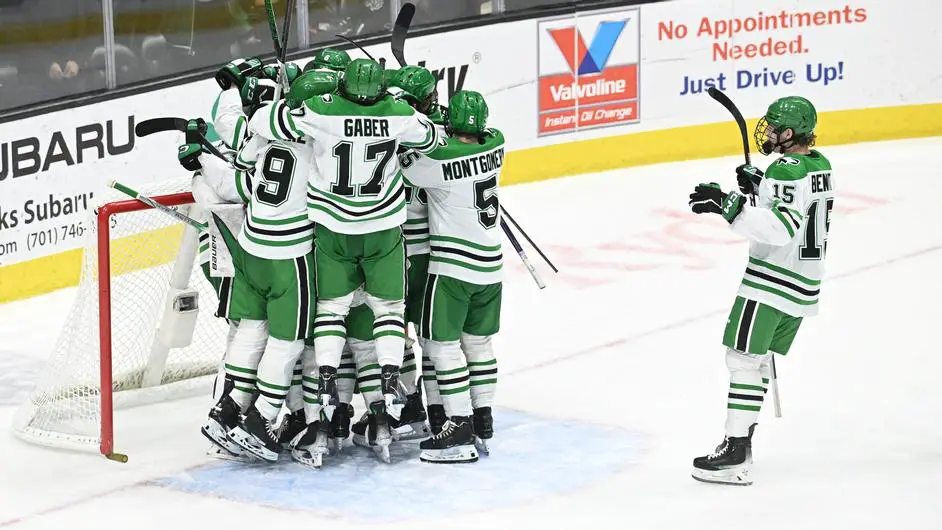
Each week during the season, we look at the big events and big games around Division I men’s college hockey in Tuesday Morning Quarterback.
Paula: Jimmy, the only place to start this week is with Boston College’s sweep of Boston University.
In beating the Terriers 4-1 at home in the Conte Forum and 4-3 in Agganis Arena, the Eagles extended their win streak to four games, halted BU’s eight-game, two-month unbeaten streak and caught up with Boston University at the top of the Hockey East standings.
That impressive performance garnered Boston College 47 first-place votes in this week’s poll – well-earned recognition of an absolute statement of a weekend. The Eagles never trailed in the series, BC’s two dynamic top lines dominated the scoring and Jacob Fowler had a .935 save percentage in the two games.
Very impressive weekend.
Boston College isn’t the only team at the top of a conference standing making. No. 2 North Dakota swept Denver a weekend after taking four points on the road from St. Cloud State, and now the Fighting Hawks are alone in first place in the NCHC.
RIT swept Bentley, extending the Tigers’ win streak to four games and creating a small bit of distance at the top of the Atlantic Hockey standings.
There’s still quite a bit of hockey to be played, but it feels to me like there are a few teams positioning themselves to take care of what business they can. How does it look to you?
Jim: I will attack the simple here. Boston College’s sweep of Boston University, the Eagles crosstown rival and then-No. 1 team, was a major statement. Granted it only lasts for about nine days until these two clash on a bigger stage – the Beanpot semifinals at TD Garden – but the high that last weekend created for the Eagles should be savored.
BC looked like the deeper team. There were more scoring among top players (BU’s Macklin Celebrini and Lane Hutson combined for just two total points). The Eagles didn’t have to dominate either game, they found wins being opportunistic.
Maybe BU has a response in the Beanpot, certainly a game that means the most to these teams. But BC has positioned itself to be in the Hockey East regular season race, maybe win it. And sitting atop the PairWise might mean the most.
The other team that stood out this weekend was North Dakota with a home sweep of Denver. We joked on our Monday podcast that North Dakota never doesn’t anything quietly, but I think on the national picture people began forgetting about the Fighting Hawks.
Right now, NoDak sits atop the NCHC and is second in the PairWise. Sure, maybe we all forgot North Dakota, but they are absolutely a top-three team in any book right now.
Paula: Isn’t it strange how a program as good as North Dakota can nearly fly under the national radar? They’re definitely a top three team, and yet they’re not at all who I think of first when looking at teams to make the Frozen Four.
Let me make it clear: that’s on me, not the Fighting Hawks.
North Dakota’s offense is fifth-best nationally (3.65), with a top-10 power play (.270) and 13 skaters who have played the entire season or nearly all season with at least two goals to their name. The Fighting Hawks’ overall defense is tied for 10th (2.42) nationally, but the penalty kill is good but not spectacular (.826).
And while Ludvig Persson’s save percentage and goals-against average aren’t among the top 10 netminders nationally, his win percentage (.696) is. Persson was solid in net against Denver, and the Fighting Hawks’ defense in front of him was even tidier – in fact, tidier than usual – allowing just 43 shots on the weekend.
One of the reasons that a team as good as North Dakota seems to have been a bit of a sleeper is that the Fighting Hawks have been steadily improving their team defense through January. There have been more than a few times this season when North Dakota has had to rely on scoring to overcome defensive lapses, and I think such teams tend to get overlooked until they appear to have more than just muscle up front.
Speaking of teams with muscle up front, it seems insane to me that so many teams this season are averaging well above 3.50 goals per game. North Dakota’s sweep of Denver is even more impressive given that the Fighting Hawks held the Pioneers to four goals in the series when Denver was averaging more than five goals per game coming into the weekend. Just a week ago, the Pioneers scored six goals in each game in their sweep of Omaha.
But look at the scores for the weekend and the national stats and tell me if I’m seeing something that isn’t really there. Teams scored five or more goals 25 times this past weekend, and in three overtime games, both teams netted five or more goals: Omaha’s 7-6 win over St. Cloud, Wisconsin’s 6-5 win over Michigan and Lindenwood’s 6-5 win over Stonehill.
Jimmy, does the adage that defense wins games need to be revised?
Jim: I think that we have watched regular season offense increase incrementally over the last few seasons and this year is no exception. That said, where we get to the most important games of the year, defense is still the most crucial factor.
Last year’s opening round of the NCAA tournament presented some of the highest scoring regional games in years. But once we were past that round, games returned to normal.
In fact, the average goals per game in regional finals (national quarterfinal round) was four. The Frozen Four gave us eight and seven goals in the two semifinals, but the winning team in each allowed only two goals. And the national title game was a 3-2 overtime game.
So yes, the scores at times can show explosive offense, but when the most important games are played defense matters.
What strikes me right now is the youth movement in college hockey, particularly among scorers. Thirteen of the top 21 scoring leaders in the nation are underclassmen (freshmen and sophomores). We’ve heard so much about the graduate transfer in the era of the five-year players. But it still seems like the youngest players in college hockey still lead the way, maybe more than ever.
Understanding that many of these players will leave before they become juniors and seniors, it’s still pretty impressive to see this level of early-career talent.
Paula: I think the World Juniors underscored that for me, Jimmy. I was astounded at the young talent from around the world but blown away completely by the amount of talent on the U.S. team. No one paying attention should be surprised at Boston College’s success this year, given what we saw of their young players in that tournament.
Weirdly, that talent hasn’t yet translated into more conference success this season for two Big Ten teams that each had four players on this year’s gold medal squad, Michigan and Minnesota.
You and I have talked before in this space about how advances in technology – from equipment to availability of information has positively impacted the game, as well as how an emphasis on player development in recent years has led to better younger players. What’s interesting to me is that the youth movement in hockey isn’t limited to what we’re seeing in the NCAA.
There are two teenagers playing in the NHL – Connor Bedard and Adam Fantilli – with goal totals in the double digits, two 20-year-olds with 10 or more goals and seven 21-year-old players with 10 or more goals. The fact that there are 133 NHL players younger than 23 years old is something to ponder.
In the AHL, five players who haven’t yet seen their 20th birthdays have 10 or more goals. Given that the AHL is as much a developmental league for the NHL as it is a place for many older players to end their careers, this isn’t too surprising, but the face of the game does seem to be trending younger and younger.
Jim: I will offer an opinion that will be unpopular among my friends in Hockey East. I actually really like the fact that North Dakota is a little bit older than some of the younger teams near the top of the PairWise.
We’ve seen in year in and year out that the extreme talent – loads of NHL draft picks, many first rounders – doesn’t always hold up against some of the more veteran teams.
North Dakota’s top five scorers are all 20 years or older, with topping that last list at 24 years of age. That’s significant given that many of the recent national champions were built on experienced, older rosters.
I’m not betting against teams like Boston College or Boston University, but I know that once you reach the single elimination NCAA tournament, experience and age matters.


